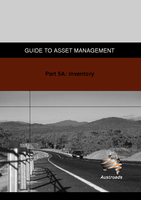Asset Management

Guide to Asset Management Part 5A: Inventory
- Publication no: AGAM05A-09
- ISBN: 978-1-921551-57-4
- Published: 9 July 2009
- Edition: 1
- Superseded
- PDF (free) Download
These guidelines are intended to assist asset managers and pavement asset managers in collecting and managing data. Part 5A addresses issues of data management, processing and location referencing. The section on data types reviews the frequently used data types in a structured form. The various data processing methods are discussed including data transformations and dynamic segmentation. The section on location referencing offers a broad review of the available location referencing methods and their implementation in Australia. This report offers an overview and the reader is encouraged to use this document as a general guide to obtain a bearing in the complex and expanding field of road data management.
- 1. INTRODUCTION
- 1.1. Context within the Guide to Asset Management
- 1.2. Overview
- 2. PURPOSE OF DATA COLLECTION
- 2.1. Reasons for Data Collection
- 2.2. Benefits of Data Collection
- 3. DATA MANAGEMENT
- 3.1. Elements of Data Management
- 3.1.1. Define Data Needs
- 3.1.2. Data Analysis and Modelling
- 3.1.3. Management Responsibilities
- 4. DATA CLASSES
- 4.1. Asset Register or Inventory
- 4.2. Condition Data
- 4.2.1. Characterisation of Condition
- 4.2.2. Evaluating Pavement Characteristics
- 4.3. Environmental Data
- 4.4. Road Use Data
- 4.5. Construction, Maintenance and Expenditure Data
- 4.6. Historical Data
- 5. DATA LEVELS – QUALITY OF INFORMATION
- 5.1. Information Quality Level (IQL)
- 5.2. Choice and Frequency of Data Collection
- 6. DATA COLLECTION METHODS
- 6.1. Desktop Study
- 6.2. Measured and Rated Data
- 6.3. The PCI Method
- 7. DATA PROCESSING
- 7.1. Data Aggregation
- 7.1.1. Data Aggregation According to Segmentation
- 7.1.2. Data Aggregation According to the Use of Data
- 7.1.3. Data Aggregation According to the Calculation Method
- 7.1.4. Index Parameters
- 7.2. Transformation and Dynamic Segmentation
- 8. LOCATION REFERENCING
- 8.1. Linear Location Referencing
- 8.1.1. Location Referencing Methods
- 8.1.2. Transformation between Location Referencing Methods
- 8.1.3. Referencing Dual Carriageways and Lanes
- 8.2. Spatial Location Referencing
- 8.2.1. GPS Accuracy
- 8.2.2. Geographical Information System
- 8.2.3. GPS and Linear Location Referencing
- REFERENCES
Related publications
WEB-GADA-24
WEB-R695-G104-2-23
Latest Asset Management News
